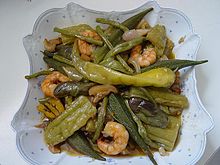


Pinakbet with shrimp
| |
| Alternative names | Pakbet |
|---|---|
| Course | Main course |
| Place of origin | Philippines |
| Region or state | Ilocos Region |
| Associated cuisine | Filipino cuisine |
| Serving temperature | Hot, room temperature |
| Main ingredients | Vegetables, bagoong (fish or shrimp) |
| Variations | Tagalog |
| Similar dishes | Dinengdeng |

Pinakbet (also called pakbet) is an indigenous Filipino dish from the northern regions of the Philippines. Pinakbet is made with a variety of mixed vegetables flavored with bagoóng.[1] The word is the contracted from the Ilokano word pinakebbet, meaning "shrunk" or "shriveled."[2]
Ilocano cuisine is characterized by dishes that are either salty or bitter, requiring rice.[3] Original Ilocano pinakbet is seasoned with bagoóng of fermented fish (buggúong nga ikán) usually of anchovies (munámon). The dish includes bitter melon (paría).[4] These two ingredients define the inclinations of the Ilocano palate.[3][5][6]
Other typical vegetables include eggplant (taróng), tomato (kamátis), okra, string beans (utóng), chilis (síli), hyacinth beans (párda), winged beans (pállang), and others. Root crops and some beans like sweet potato (kamótig), lima beans (patáni), pigeon peas (kárdis) are optionally added. Aromatics such as ginger (layá), shallots (sibúyas), and garlic (báwang) are commonly added. Many of these vegetables are easily accessible and are grown in the backyards and gardens of most Ilocano households.[7][8]
Smaller vegetables are left whole or partially sliced in half (okra, tomatoes, chilis, hyacinth beans, smaller varieties of bitter melon and eggplants, aromatics), larger vegetables are cut into finger-length size (thinner eggplants, yardlong beans, winged beans), chopped into smaller chunks (larger varieties of bitter melon, sweet potatoes), and beans shelled from their pods (lima, pigeon peas).
Absent from this list is calabaza (karabasa). Although widely grown in the Ilocos region, historically the cooking of calabaza was omitted from pinakbet because it took longer to cook in a claypot over a wood fire, compared to the other vegetables.
Bagoong provides the base. However, dried whole krill or smaller shrimps (áramang), larger headless dried shrimps (hébi), and dried anchovies, can be used to further enhance the broth similar to Japanese dashi (出汁) or Korean dasima (다시마) without having to use MSG. Other than for the aromatic vegetables (garlic, ginger, shallots), no other flavoring enhancers and spices such as peppercorns or bay leaves are used.[9]
Pinakbet remains a straightforward healthy vegetable dish containing no meat.[9][10] In Ilocano cuisine, meats are typically prepared separately on its own such as adoboordinuguan (dinárdaraan) which contains no vegetables (or very few).[11] Rather, meats including fish can be added as a garnish (ságpaw), typically stale or leftover lechon (lítson), chicharron (bágnetortsitsarón) or fried fish (príto nga ikán). Rare and highly prized ingredients of fresh shrimps (pasáyan) or prawns (udáng) could also be used as sagpaw, when available.[3][12]
Fats or oils are not used in the original preparation, either for the vegetables or proteins. The vegetables are cooked in a method between shallow boiling and steaming.[9] A small amount of water is boiled in a pot (bánga). Some of this water is added to a bowl containing a small amount of buggúong. The buggúong is macerated with the water to dissolved. This mixture is then strained over the pot to remove fish debris such as bones to create a fish broth.[9] The aromatics are added to the flavor the fish broth and optionally seasoned with the dried shrimp or anchovies, followed by the vegetables.[9] To mix, the vegetables are gently tossed within the pot without the use a utensil to keep them relatively intact. As its name suggests, these vegetables are cooked until "shriveled". Leftover meats or seafood garnishes can be added near the end of the cooking time.[12]

In areas outside of the Ilocos Region, shrimp paste (bagoóng alamáng) is commonly used in place of anchovy paste. Other non-Ilocano ("Tagalog") preparations include sauteing pork, adding calabaza (kalabasa), using flavoring agents like Maggi liquid seasoning or "Magic Sarap," bouillon cube, fish sauce (patis), oyster sauce, meat stock, spices, bay leaves and pepper, or stewing in coconut milk.[13][14][9]
{{cite journal}}: CS1 maint: multiple names: authors list (link)
{{cite journal}}: CS1 maint: multiple names: authors list (link)
{{cite journal}}: Cite journal requires |journal= (help)
|
| |
|---|---|
| |
|